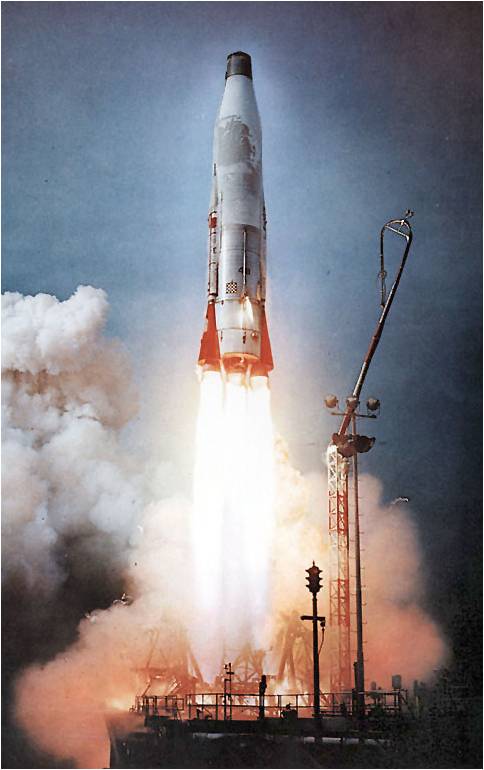Fifty-two years ago today, an Atlas B flew 2,500 miles down the Eastern Test Range in a key developmental test of America’s first Intercontinental Ballistic Missile (ICBM). Among other historic achievements, the test marked the first successful flight of the innovative stage-and-a-half missile.
The infamous Cold War between the United States and the Soviet Union was marked by the specter of nuclear confrontation. Each side developed a family of launch vehicles that could deliver nuclear ordnance to the homeland of the other. The type of launch vehicle employed is known as an Intercontinental Ballistic Missile (ICBM).
An ICBM flies a long, arcing (sub-orbital) trajectory to the target. This flight path is parabolic in shape and thousands of miles in range. The maximum altitude point (apogee) is about mid-way to the target and is located hundreds of miles above the surface of the Earth. An ICBM can reach any point on the globe within 30 minutes of launch.
The first ICBM developed by the United States was the Atlas missile. The origins of this program date back to late 1945 when the United States Army requested proposals from the aerospace industry for novel long-range missile concepts. Consolidated-Vultee Aircraft (Convair) caught the Army’s eye with a missile design that ultimately became the Atlas.
The Atlas was innovative from a number of standpoints. Perhaps most novel was the use of very thin stainless steel tankage in an effort to provide the Atlas with an extremely lightweight structure. However, the tank was so thin that a screwdriver could easily puncture its walls. Moreover, the tank would collapse even under its own weight. Nitrogen pressurization was employed to obtain the necessary structural rigidity.
Another Atlas innovation involved the use of the so-called stage-and-a-half or parallel staging propulsion concept. This system was comprised of a pair of outboard boosters (Stage 0) and a single sustainer core (Stage 1). These engines burned a LOX/kerosene propellant mix and were ignited at launch. Stage 0 was jettisoned after 135 seconds of flight. The sustainer continued to fire an additional 95 seconds.
Atlas A was first flown in June of 1957. The type operated the booster engines only and carried a mass simulator warhead. Only three (3) of its eight (8) developmental flight tests were considered successful. The type achieved a maximum range of 600 nm during its third flight which occurred on Tuesday, 17 December 1957.
Atlas B was the first Atlas test vehicle to operate both the booster and sustainer rocket engines. The vehicle measured 85 feet in length and had a diameter of 10 feet. Lift-off weight was slightly over 244,000 pounds. Its XLR89-5 booster engines and XLR105-5 sustainer engine generated 341,130 and 81,655 pounds of vacuum thrust, respectively.
Atlas B test vehicles flew ten (10) times and enjoyed seven (7) successful flight tests. The first launch (Atlas B, Serial No. 3B) occurred on Friday, 19 July 1958 and was not successful. Atlas B, Serial No. 4B lifted-off from Cape Canaveral’s LC-13 at 22:16 UTC on Saturday, 02 August 1958. This test was entirely successful as the missile reached an apogee of 560 miles and traveled 2,500 miles downrange.
In the years that followed, other Atlas variants were developed including the Atlas C, D, E, F, G and H. Atlas C was the first pre-production version of the Atlas Program. Atlas D was the first operational version of the Atlas ICBM. Atlas E and Atlas F missiles were the first ICBM’s stored in underground silos and raised to ground level for launch. Atlas G and H launched numerous space exploration payloads.
Ironically, the Atlas did not serve long in its primary role as an ICBM. The type was quickly eclipsed by more capable launch vehicles such as the Titan II. However, the Atlas would be used to great effect as a launch vehicle for a wide variety of satellites and scientific spacecraft. The Atlas was ultimately man-rated as a booster. It was used to successfully orbit Mercury astronauts during four (4) Mercury missions flown in 1962 and 1963.
The Atlas has continued to evolve as a commercial launch platform to the current day. The Atlas I was introduced in July of 1990. It was followed by the Atlas II and Atlas III in 1991 and 2000, respectively. The Atlas V is the most recent Atlas variant and first flew in 2002. Significantly, the Atlas is the longest running launch vehicle program in the history of American spaceflight.

